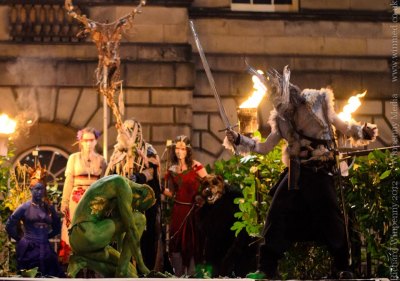“Make ceremonies out of air and breathe upon them.”
— Cormac McCarthy, The Road (2006)
The uniqueness of Neo-Paganism lies not in the centrality of ritual, but in the centrality of intentional ritual creation. Every religious tradition has rituals, even if they do not recognize them as such. Neo-Paganism is unique in that its ritual forms often come from the imagination of its individual practitioners. In fact, some Neo-Pagans have raised ritual creation to an art form.
There is no tradition to which Neo-Pagans have to conform. So from a very early point in the evolution of Neo-Paganism, its practitioners acknowledged and embraced the fact that they were “making it up as they went along” and “stealing from any source that didn’t run away too fast.”
The Neo-Pagan practice of intentional ritual creation dates back at least to the formation of the New Reformed Orthodox Order of the Golden Dawn (NROOGD) in 1967. NROOGD actually began as an assignment for a college class on ritual at San Francisco State University. Aidan Kelly begins his account of the formation of NROOGD with the following quote by Elliot Rose:
“Few indeed have been those with the audacity to stand forth as the inventor of a spell, a charm, an invocation; few have felt so self-reliant as to admit that they taught themselves what they knew of hidden truths.”
This eclectic attitude was pragmatic, the natural result of the absence of available sources on the Wiccan tradition he wanted to emulate. According to Wiccan priest, Frederic Lamond, Gardnerian Wicca did not arrive on the West Coast until 1973. Living on the West Coast in the late 1960s, at the epicenter of the American Counterculture, it was inevitable that the forms of Neo-Paganism that arose at that time and place would be experimental and eclectic in nature. Although drawing on the same sources as the Gardnerians (i.e., Charles Leland, Margaret Murray, and Robert Graves), the NROOGD rituals differed significantly from Gardnerian Wicca. Writing and performing original rituals continues to be an important part of membership in NROOGD today.
Some examples of the creative nature of Neo-Pagan ritual include Zsuzsanna Budapest’s Feminist Book of Light and Shadow published in 1975 (republished in 1989 as The Holy Book of Women’s Mysteries) and Starhawk’s Spiral Dance (1979). These books contain unique feminist Neo-Pagan liturgies that drew on the writings of Gerald Gardner, Robert Graves, Jane Ellen Harrison, and Carl Jung (usually without citing their sources) and combined these with poetry and liturgy of the authors’ own creation.
Below are two examples of rituals which I created, borrowing from other sources.
